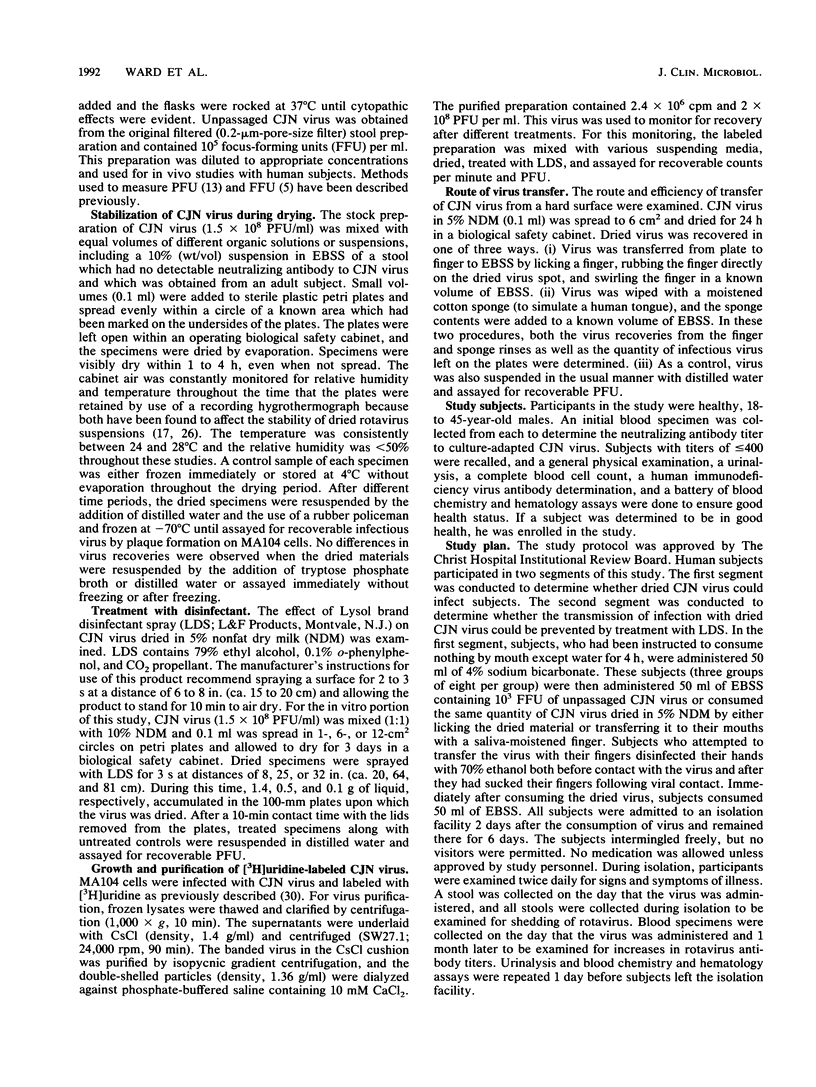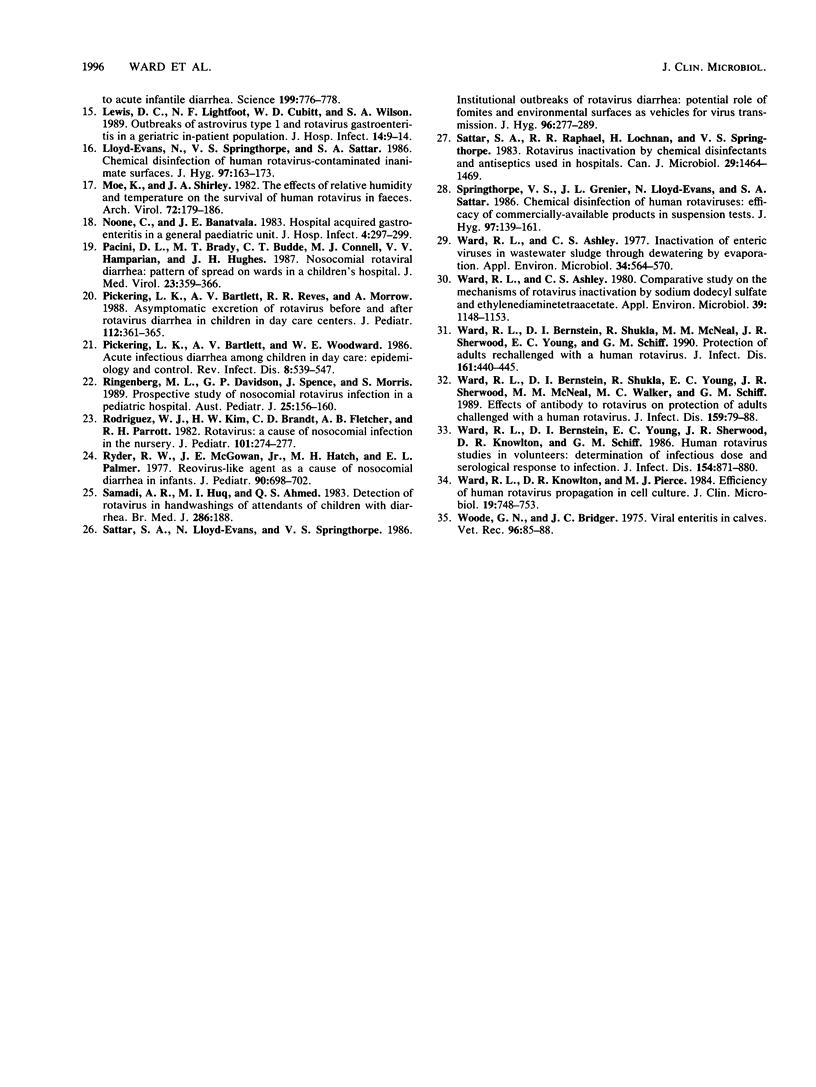Abstract
A model was developed to examine the effects of disinfectants on the transmission of infectious rotavirus from a dried surface to humans. The initial experiments were designed to find a method of preserving rotavirus infectivity during drying. Culture-adapted human rotavirus (CJN strain) was dried at room temperature in different organic suspensions, including fecal matter, several laboratory media, and nonfat dry milk (NDM). Recoveries of infectious virus were then compared. Fecal matter provided little protection in this study relative to distilled water, but the other suspensions were quite protective, especially NDM, which consistently allowed recoveries of greater than 50%. When 10(3) focus-forming units of unpassaged CJN virus were dried in NDM and administered to subjects who licked the dried material, 100% (8 of 8) became infected. The effect of Lysol brand disinfectant spray (LDS) was next examined. Although NDM provided some protection against inactivation by LDS, spraying under conditions recommended by the manufacturer consistently caused the CJN virus titer to decrease greater than 5 log10. Consumption of CJN virus (10(3) focus-forming units) sprayed with LDS caused no infection in 14 subjects, whereas 13 of 14 subjects who consumed the unsprayed virus became infected (P less than 0.00001). The methods developed in this study could be used to test the effects of other disinfectants on the spread of infectious rotavirus from inanimate surfaces to humans.
Full text
PDF





Selected References
These references are in PubMed. This may not be the complete list of references from this article.
- Ansari S. A., Sattar S. A., Springthorpe V. S., Wells G. A., Tostowaryk W. In vivo protocol for testing efficacy of hand-washing agents against viruses and bacteria: experiments with rotavirus and Escherichia coli. Appl Environ Microbiol. 1989 Dec;55(12):3113–3118. doi: 10.1128/aem.55.12.3113-3118.1989. [DOI] [PMC free article] [PubMed] [Google Scholar]
- Ansari S. A., Sattar S. A., Springthorpe V. S., Wells G. A., Tostowaryk W. Rotavirus survival on human hands and transfer of infectious virus to animate and nonporous inanimate surfaces. J Clin Microbiol. 1988 Aug;26(8):1513–1518. doi: 10.1128/jcm.26.8.1513-1518.1988. [DOI] [PMC free article] [PubMed] [Google Scholar]
- Barrón-Romero B. L., Barreda-González J., Doval-Ugalde R., Zermeño-Eguia Liz J., Huerta-Peña M. Asymptomatic rotavirus infections in day care centers. J Clin Microbiol. 1985 Jul;22(1):116–118. doi: 10.1128/jcm.22.1.116-118.1985. [DOI] [PMC free article] [PubMed] [Google Scholar]
- Bartlett A. V., 3rd, Reves R. R., Pickering L. K. Rotavirus in infant-toddler day care centers: epidemiology relevant to disease control strategies. J Pediatr. 1988 Sep;113(3):435–441. doi: 10.1016/S0022-3476(88)80624-3. [DOI] [PMC free article] [PubMed] [Google Scholar]
- Bernstein D. I., Kacica M. A., McNeal M. M., Schiff G. M., Ward R. L. Local and systemic antibody response to rotavirus WC3 vaccine in adult volunteers. Antiviral Res. 1989 Dec;12(5-6):293–300. doi: 10.1016/0166-3542(89)90056-9. [DOI] [PubMed] [Google Scholar]
- Brashear D. A., Ward R. L. Inactivation of indigenous viruses in raw sludge by air drying. Appl Environ Microbiol. 1983 Jun;45(6):1943–1945. doi: 10.1128/aem.45.6.1943-1945.1983. [DOI] [PMC free article] [PubMed] [Google Scholar]
- Clark J. D., Hill S. M., Phillips A. D. Investigation of hospital-acquired rotavirus gastroenteritis using RNA electrophoresis. J Med Virol. 1988 Nov;26(3):289–299. doi: 10.1002/jmv.1890260309. [DOI] [PubMed] [Google Scholar]
- Di Matteo A., Sarasini A., Scotta M. S., Parea M., Licardi G., Gerna G. Nosocomial outbreak of infant rotavirus diarrhea due to the appearance of a new serotype 4 strain. J Med Virol. 1989 Feb;27(2):100–104. doi: 10.1002/jmv.1890270206. [DOI] [PubMed] [Google Scholar]
- Hjelt K., Krasilnikoff P. A., Grauballe P. C., Rasmussen S. W. Nosocomial acute gastroenteritis in a paediatric department, with special reference to rotavirus infections. Acta Paediatr Scand. 1985 Jan;74(1):89–95. doi: 10.1111/j.1651-2227.1985.tb10926.x. [DOI] [PubMed] [Google Scholar]
- Keswick B. H., Pickering L. K., DuPont H. L., Woodward W. E. Prevalence of rotavirus in children in day care centers. J Pediatr. 1983 Jul;103(1):85–86. doi: 10.1016/s0022-3476(83)80785-9. [DOI] [PubMed] [Google Scholar]
- Keswick B. H., Pickering L. K., DuPont H. L., Woodward W. E. Survival and detection of rotaviruses on environmental surfaces in day care centers. Appl Environ Microbiol. 1983 Oct;46(4):813–816. doi: 10.1128/aem.46.4.813-816.1983. [DOI] [PMC free article] [PubMed] [Google Scholar]
- Knowlton D. R., Ward R. L. Effect of mutation in immunodominant neutralization epitopes on the antigenicity of rotavirus SA-11. J Gen Virol. 1985 Nov;66(Pt 11):2375–2381. doi: 10.1099/0022-1317-66-11-2375. [DOI] [PubMed] [Google Scholar]
- Lewis D. C., Lightfoot N. F., Cubitt W. D., Wilson S. A. Outbreaks of astrovirus type 1 and rotavirus gastroenteritis in a geriatric in-patient population. J Hosp Infect. 1989 Jul;14(1):9–14. doi: 10.1016/0195-6701(89)90128-x. [DOI] [PubMed] [Google Scholar]
- Lloyd-Evans N., Springthorpe V. S., Sattar S. A. Chemical disinfection of human rotavirus-contaminated inanimate surfaces. J Hyg (Lond) 1986 Aug;97(1):163–173. doi: 10.1017/s0022172400064445. [DOI] [PMC free article] [PubMed] [Google Scholar]
- Moe K., Shirley J. A. The effects of relative humidity and temperature on the survival of human rotavirus in faeces. Arch Virol. 1982;72(3):179–186. doi: 10.1007/BF01348963. [DOI] [PubMed] [Google Scholar]
- Noone C., Banatvala J. E. Hospital acquired rotaviral gastroenteritis in a general paediatric unit. J Hosp Infect. 1983 Sep;4(3):297–299. doi: 10.1016/0195-6701(83)90031-2. [DOI] [PubMed] [Google Scholar]
- Pacini D. L., Brady M. T., Budde C. T., Connell M. J., Hamparian V. V., Hughes J. H. Nosocomial rotaviral diarrhea: pattern of spread on wards in a children's hospital. J Med Virol. 1987 Dec;23(4):359–366. doi: 10.1002/jmv.1890230408. [DOI] [PubMed] [Google Scholar]
- Pickering L. K., Bartlett A. V., 3rd, Reves R. R., Morrow A. Asymptomatic excretion of rotavirus before and after rotavirus diarrhea in children in day care centers. J Pediatr. 1988 Mar;112(3):361–365. doi: 10.1016/s0022-3476(88)80313-5. [DOI] [PubMed] [Google Scholar]
- Pickering L. K., Bartlett A. V., Woodward W. E. Acute infectious diarrhea among children in day care: epidemiology and control. Rev Infect Dis. 1986 Jul-Aug;8(4):539–547. doi: 10.1093/clinids/8.4.539. [DOI] [PubMed] [Google Scholar]
- Ringenbergs M. L., Davidson G. P., Spence J., Morris S. Prospective study of nosocomial rotavirus infection in a paediatric hospital. Aust Paediatr J. 1989 Jun;25(3):156–160. doi: 10.1111/j.1440-1754.1989.tb01441.x. [DOI] [PubMed] [Google Scholar]
- Rodriguez W. J., Kim H. W., Brandt C. D., Fletcher A. B., Parrott R. H. Rotavirus: a cause of nosocomial infection in the nursery. J Pediatr. 1982 Aug;101(2):274–277. doi: 10.1016/s0022-3476(82)80140-6. [DOI] [PubMed] [Google Scholar]
- Ryder R. W., McGowan J. E., Hatch M. H., Palmer E. L. Reovirus-like agent as a cause of nosocomial diarrhea in infants. J Pediatr. 1977 May;90(5):698–702. doi: 10.1016/s0022-3476(77)81230-4. [DOI] [PubMed] [Google Scholar]
- Samadi A. R., Huq M. I., Ahmed Q. S. Detection of rotavirus in handwashings of attendants of children with diarrhoea. Br Med J (Clin Res Ed) 1983 Jan 15;286(6360):188–188. doi: 10.1136/bmj.286.6360.188. [DOI] [PMC free article] [PubMed] [Google Scholar]
- Sattar S. A., Lloyd-Evans N., Springthorpe V. S., Nair R. C. Institutional outbreaks of rotavirus diarrhoea: potential role of fomites and environmental surfaces as vehicles for virus transmission. J Hyg (Lond) 1986 Apr;96(2):277–289. doi: 10.1017/s0022172400066055. [DOI] [PMC free article] [PubMed] [Google Scholar]
- Sattar S. A., Raphael R. A., Lochnan H., Springthorpe V. S. Rotavirus inactivation by chemical disinfectants and antiseptics used in hospitals. Can J Microbiol. 1983 Oct;29(10):1464–1469. doi: 10.1139/m83-225. [DOI] [PubMed] [Google Scholar]
- Springthorpe V. S., Grenier J. L., Lloyd-Evans N., Sattar S. A. Chemical disinfection of human rotaviruses: efficacy of commercially-available products in suspension tests. J Hyg (Lond) 1986 Aug;97(1):139–161. doi: 10.1017/s0022172400064433. [DOI] [PMC free article] [PubMed] [Google Scholar]
- Ward R. L., Ashley C. S. Comparative study on the mechanisms of rotavirus inactivation by sodium dodecyl sulfate and ethylenediaminetetraacetate. Appl Environ Microbiol. 1980 Jun;39(6):1148–1153. doi: 10.1128/aem.39.6.1148-1153.1980. [DOI] [PMC free article] [PubMed] [Google Scholar]
- Ward R. L., Ashley C. S. Inactivation of enteric viruses in wastewater sludge through dewatering by evaporation. Appl Environ Microbiol. 1977 Nov;34(5):564–570. doi: 10.1128/aem.34.5.564-570.1977. [DOI] [PMC free article] [PubMed] [Google Scholar]
- Ward R. L., Bernstein D. I., Shukla R., McNeal M. M., Sherwood J. R., Young E. C., Schiff G. M. Protection of adults rechallenged with a human rotavirus. J Infect Dis. 1990 Mar;161(3):440–445. doi: 10.1093/infdis/161.3.440. [DOI] [PubMed] [Google Scholar]
- Ward R. L., Bernstein D. I., Shukla R., Young E. C., Sherwood J. R., McNeal M. M., Walker M. C., Schiff G. M. Effects of antibody to rotavirus on protection of adults challenged with a human rotavirus. J Infect Dis. 1989 Jan;159(1):79–88. doi: 10.1093/infdis/159.1.79. [DOI] [PubMed] [Google Scholar]
- Ward R. L., Bernstein D. I., Young E. C., Sherwood J. R., Knowlton D. R., Schiff G. M. Human rotavirus studies in volunteers: determination of infectious dose and serological response to infection. J Infect Dis. 1986 Nov;154(5):871–880. doi: 10.1093/infdis/154.5.871. [DOI] [PubMed] [Google Scholar]
- Ward R. L., Knowlton D. R., Pierce M. J. Efficiency of human rotavirus propagation in cell culture. J Clin Microbiol. 1984 Jun;19(6):748–753. doi: 10.1128/jcm.19.6.748-753.1984. [DOI] [PMC free article] [PubMed] [Google Scholar]
- Woode G. N., Bridger J. C. Viral enteritis of calves. Vet Rec. 1975 Jan 25;96(4):85–88. doi: 10.1136/vr.96.4.85. [DOI] [PubMed] [Google Scholar]


